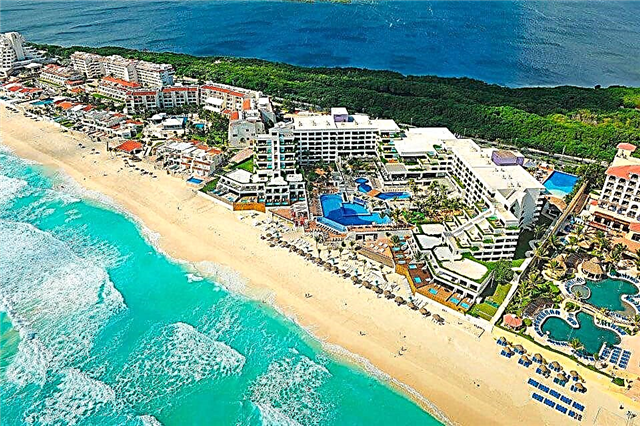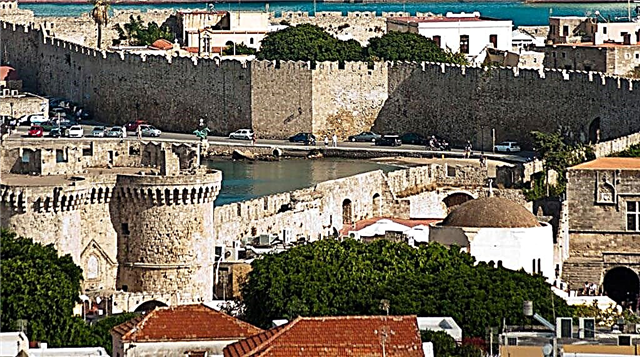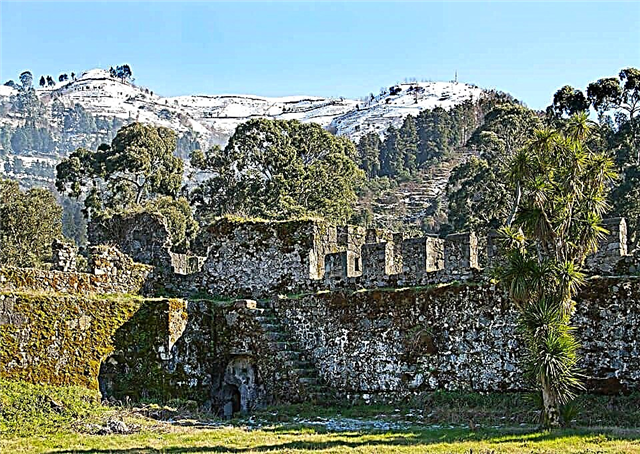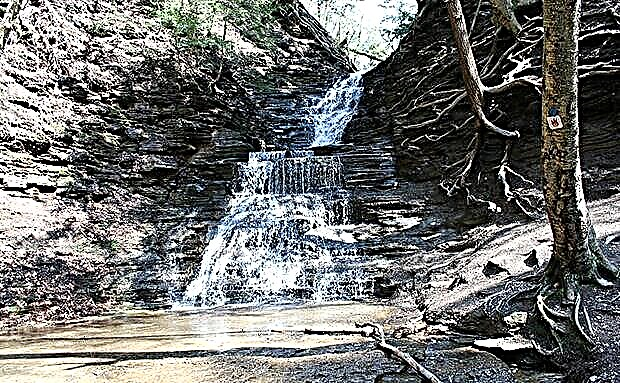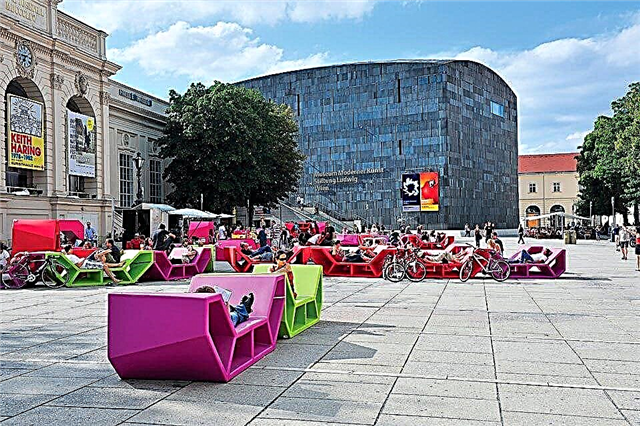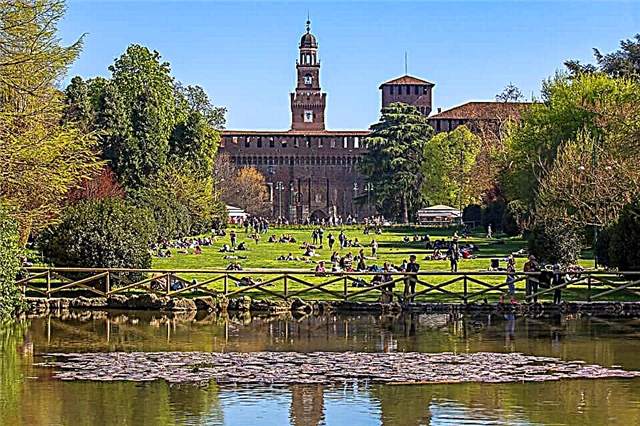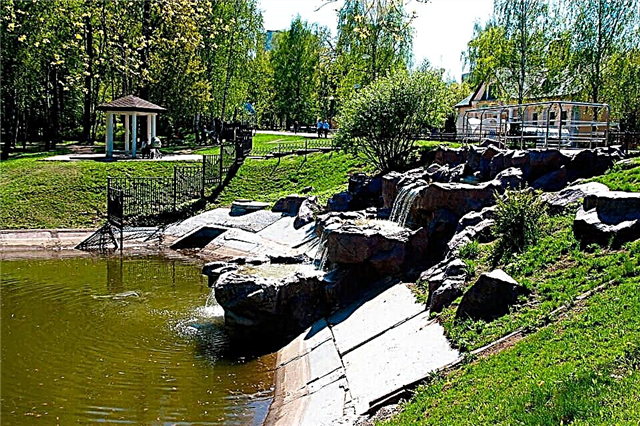Every year the number of high-rise buildings in the Russian capital is growing inexorably. But to call the Gold-domed stone jungle would be wrong. In the metropolis, there was also a place for green oases, where, far from the city noise, you can wander along shady alleys, ride a bicycle or read a book while sitting on a comfortable bench. The best parks in Moscow for walking invite you to breathe in the fresh air and admire the joint work of nature and man.
Gorky Park

Green lungs of the capitals offer residents and visitors of the city a break from the hustle and bustle and exhaust gases of cars. The park with an area of 219.7 hectares was founded in 1928. Today, the vast territory includes a walking area, an amusement area, the Muzeon sculpture park, Vorobyovy Gory and Neskuchny Garden.
A cozy corner of nature in the center of the capital gives a lot of opportunities for year-round recreation. In summer, it is good to wander along the well-groomed paths lost among age-old trees, become a spectator of an open-air concert, plow the surface of local ponds on a catamaran, and lie on a comfortable sun lounger to sunbathe.
Athletes will appreciate the tennis courts, free yoga school, bike paths, playgrounds and strength training areas. In winter, figure skating and speed skating fans come to the right bank of the Moskva River. They are attracted by the largest artificial ice rink in Europe with an area of 15 thousand m2.
Zaryadye

The newest symbol of the metropolis is spread out in the holy of holies of the capital - next to Red Square. Muscovites received a gift in the form of a modern recreation and entertainment area in 2017. Its modest size (0.13 km2) did not prevent it from gaining popularity among townspeople and tourists.
However, one should not hope that one can walk here in the shade of lush vegetation - the authors of "Zaryadye" set completely different goals for themselves.
This place is called "a miracle of engineering". On the territory, representing a symbiosis of natural landscapes and climatic zones of Russia, innovative objects were placed: the Philharmonic, the underground archaeological museum, the Conservation Embassy, the interactive Media Center and the gourmet paradise - the Gastronomic Pavilion. Recently, the kingdom of the Snow Queen appeared here - an ice cave with an area of 350 m2.
The heart of the park is the floating bridge, from the height of which you can take a photo of the Moskva River embankment and the Kremlin towers.
Sokolniki

One of the few places in Moscow where the spirit of the end of the last century has been preserved. There are still couples spinning in a waltz on the Veranda of Dances, pensioners gambling at dominoes, and schoolchildren competing in "Bouncers" at the Pioneer Creative Center.
A rope complex, a trampoline arena and modern attractions coexist peacefully with good old carousels. There are hobby clubs for dog breeders, chess players and calligraphers, and for ornithology lovers there is the only bird house in Russia.
A corner of nature is located in the north-east of the city and covers an area of 5.16 km2. Sokolniki is always fun and interesting. Adults and children are invited to educational forums, bike paths, a sports alley, a swimming pool, a go-kart center, a large rose garden, a money garden, a living corner, cafes and restaurants.
Every year, thousands of those with a sweet tooth flock to the Ice Cream Festival, and those who wish to have a hearty meal will find the Food Truck Festival.
Alexander Garden

Previously, the Neglinka River flowed here. In 1819, the shallow water artery was enclosed in a pipe, and a park was laid out in its place. The order to create the garden was given by Alexander I, after him and the green corner in the heart of Belokamennaya was named. Three alleys cut through 10 hectares of lawns and natural landscapes, located between the territory of the Kremlin and Manezhnaya Square. The park area is schematically divided into three parts.
The upper garden welcomes guests with a cast-iron gate decorated with gilded elements symbolizing military victories. On the left - a memorial dear to the heart of every Russian - the Eternal Flame, the Tomb of the Unknown Soldier and steles that personify the hero cities.
Further - the Italian grotto and the Romanovsky obelisk. Walking among fountains, sculptures, flower beds and figurines of fairy-tale heroes, visitors across the Trinity Bridge find themselves in the Middle Garden - the kingdom of silence, birdsong and beautiful landscapes. The lower garden is closed to the public.
Victory Park

The park next to Kutuzovsky Prospekt is the most important landmark of the city and a landmark place for veterans - heroes of the Great Patriotic War. The complex located in the Western District of the capital reminds contemporaries of the horrors of 1941-1945 and the victory of the Soviet Union.
The architectural ensemble includes:
- Victory monument
- War museum
- Church of St. George the Victorious
- Museum dedicated to the victims of the Holocaust
- Synagogue
- Memorial mosque
- Sculpture "Tragedy of Nations"
- Monument to Soldiers Performing International Duty
- Exhibition of weapons and military equipment
It is good to come to Poklonnaya Gora with the whole family. The objects of the memorial acquaint children with the history of the Motherland and the patriotism of its sons. A theme center for attractions has been built next to the complex. Slides, carousels, boats and cars will not only entertain young visitors, but also illustrate military equipment and episodes of battles.
MUSEON Art Park

Guests of Gorky Park are greeted by a unique open-air museum, which has collected about 800 wooden, stone and bronze figures. With the light hand of Muscovites, this place is called the cemetery of sculptures. Such a strange name is associated with the history of the park.
In 1970, the construction of a new building for the Tretyakov Gallery began on Krymsky Val. The grandiose structure was completed in 9 years. However, the nearby construction waste dump “delighted” the townspeople for a long time, until the artists turned it into a park.
The main part of Muzeon's collection is made up of sculptures of the Soviet period, which were left overboard after the coup d'état of 1991. Abstract figures, monuments to the leaders of the Soviet people, great writers and heroes of books are located on an area of 24 hectares.
The historical artifacts are also accompanied by modern compositions dedicated to the years of the Great Patriotic War and the Stalinist repressions.
Boring Garden

A cozy resting place is part of the modern Gorky Park. The oldest landscape park Zlatoglava reminds of three capital's noble possessions - the estates of the Orlovs, Demidovs, Golitsyns and the Trubetskoy estate, called Neskuchnoye.
In 1847, Nicholas I acquired the property of the Moscow princes, creating a huge park on the lands of the estates. A boring garden gives not only an opportunity to take a break from the noise and get a portion of fresh air.
He collected the sights of several eras. Walking through the forest, where it is cool even in summer heat, you will meet the Alexandria Palace, erected in the middle of the 18th century, the house of Count Orlov in 1796, the snow-white rotunda built for the 800th anniversary of the city, the mineralogical museum, bridges and the Grotto pavilion.
In 2007, the family of shady paths was supplemented by the Alley of Love - a meeting place for lovers, decorated with a clock with forever frozen hands.
Babushkinsky park

On Losiny Island, on the territory of the former town of Babushkin, there are the lungs of the north of Moscow - Babushkinsky Park - a place for leisurely walks and relaxation. The first plants of the recreation area were planted in 1898, and after 7 years the territory was ennobled with playgrounds, well-groomed paths, a winter pavilion and a summer theater. Babushkinsky Park is ready to receive guests all year round.
In warm weather, here you can ride a horse or in an old carriage, rent rollers, a bicycle or an electric car, work out on simulators, admire the play of water by a light and music fountain, watch a movie in the 5D summer cinema and sit in open cafes with the whole family.
Children will be delighted with the inflatable town and the complex of attractions. Those who cannot imagine themselves without the Internet can spend time with their gadget friends in the free Wi-Fi zone. In winter, ice slides, an ice rink and a figure skating school open.
Pharmaceutical garden

You can walk among native birches and overseas palms, learn what insectivorous plants look like, watch water turtles, goldfish and Iriskaya iguana in the garden of the Faculty of Biology of Moscow State University.
The corner of wildlife owes its origin to Peter I, according to whose decree in 1706 a garden of medicinal herbs and plants was created on the northern outskirts of the capital (now the Ramenki district). In 1805, the pharmaceutical garden was bought by Moscow University.
This place is a paradise for photographers and lovers of botany. The first ones will take hundreds of pictures of picturesque landscapes here. The latter will discover plants from all over the world: American ferns, European rhododendrons, Far Eastern heather, Siberian cedar, desert cacti and succulents, northern lichens, mosses and live stones, exotic papaya and guava, tropical vines, bananas and bromeliads.
From December to March, the Rare Orchid Festival takes place in the garden.
Brateevsky cascade park

A unique object, created by the joint efforts of man and nature, is located in the southeast of the metropolis. The green area, stretching over 42 hectares, is remarkable for its relief. Man-made terraces-cascades, originating from Borisovskie Prudy Street, descend to the bank of the Moskva River.
The walking area pleases the eye with alleys with panoramic views of the embankment, comfortable staircases, comfortable playgrounds, decorative lamps, flower beds and cozy gazebos.
The park was donated to Muscovites in 2006. Until this moment, the inhabitants of Brateevo gazed at the unattractive wasteland and swampy dams. During the construction of the Lefortovo tunnel in 2001, the city authorities decided to use the released soil for the improvement of the territory. Today, the park is a quiet recreation area, loved by mothers with strollers and young athletes occupying simulators and the football field.
Sparrow Hills

An urban legend says that earlier on the territory of today's nature reserve there was a village owned by a priest named Sparrow.
The green area was named after the clergyman. Now this place has been chosen by connoisseurs of forest walks and sports fans. The territory of the forest park is cut by a 10-kilometer pedestrian zone of the Moskva River embankment, equipped with roller and bicycle rental points.
Photographers also drop in - a green oasis in the south-west of the city is equipped with an observation deck with a panoramic view. Climb it using the cable car. From a height of 80 m, endless possibilities for landscape and city photography open up.
The skyscrapers of Moscow City, Stalin's skyscrapers on Kudrinskaya Square, the Novodevichy Convent, the Moskva River with snow-white ships, Luzhnetskaya Embankment, Berezhkovsky Bridge and the Luzhniki sports complex appear before the audience.
Manor Kuskovo

An old estate in the east of the capital will help you to travel back in time, get acquainted with the architecture, culture and noble life of the 18th century, see the expositions of the only museum in Russia exhibiting a collection of ceramics and glass, enjoy peace and quiet.
The former suburban estate of the Sheremetyev family, used for festivities and lavish receptions, has been remarkably preserved to this day. An island of beauty and harmony greets its guests with an alley that goes around a picturesque pond.
Walking along the well-groomed paths, you will admire:
- Home church
- Castle
- Italian, Dutch and Swiss houses
- Manageries
- Aviary
- Pavilion "Grotto"
- Pavilion "Hermitage"
- Great stone and American greenhouse
The complex includes a French park, with strict geometric lines, statues and flower beds reminiscent of the gardens of Versailles.
Izmailovsky Kremlin and park

More than 300 hectares of forest are included in the possession of the largest metropolitan park of culture and recreation in Izmailovo. Since 1931, the natural area in the east of Moscow has been offering entertainment for all ages.
Children will spend time in the town of attractions, including a huge Ferris wheel and a rope panda town. Adults can rent a bicycle, ride a horse with a breeze, and sail on a catamaran.
On the outskirts of the park, where the street vernissage worked in the 70s and 90s of the 20th century, the Izmaylovo Kremlin, which delights with bright colors and graceful forms, now rises. And although stylized antique buildings appeared in the 21st century, they fully recreate the atmosphere of Romanov Russia.
Here you will find a quaint dining palace, St. Nicholas Church, Flea Market, vodka, toy and Russian costume museums. Those who wish can take master classes from potters, woodcarvers, weavers, bakers, blacksmiths and candle makers.
Main Botanical Garden named after N.V. Tsitsin of the Russian Academy of Sciences

In the north-east of the city, not far from the All-Russian Exhibition Center, is the Ostankino forest park. In 1945, the Botanical Garden was founded on its territory, which later became the largest in Europe.
Here, among the numerous ponds, coniferous forests, centuries-old oak groves, thickets of willow, juniper, birch and aspen groves, only the spire of the TV Tower, rising above the crowns of trees, reminds of the noisy metropolis.
The greatest interest in the park, which occupies 360 hectares, is represented by the Stock Conservatory and the Japanese Garden. In the greenhouse, which includes two buildings, the inhabitants of the subtropics found shelter: palm trees, laurels, cypresses, dracaena, succulents, azaleas, camellias, rhododendrons and a real baobab.
The second attraction, the island of the Land of the Rising Sun, is a landscape composition that combines a stone pagoda of the 18th century, a stream, a cascade of waterfalls, traditional bridges and lanterns. The garden is especially beautiful in spring, during the cherry blossom season.
Lianozovsky park

The history of the beloved park of residents of the northeast of Belokamennaya dates back to 1932. In the 19th century, the Altufyevo estate was located in these places, which at the turn of the century passed into the possession of the oil industrialist Lianozov. The village was named in his honor, and then the Moscow region and the recreation area located on its territory. Today, the park is the rare case when reality turns out to be better than photographs on the Internet.
Once here, you find yourself in the kingdom of flora and fauna. The dendrological composition includes 70 plant species. Squirrels live in their crowns - Ginger and Donut. A special place is occupied by an oak grove, the mighty inhabitants of which rise to 25 m.
Graceful swans add a romantic atmosphere to the six ponds and disturb the fishermen who are frozen with fishing rods on the shore. This natural harmony is complemented by figurines of fairytale heroes, a “singing” fountain, a waterfall, a rope town and a club “Matador”, where horse riding is taught.
Zoo

Walk among animals from all over the world, take a trip to the possession of spiders and to a coral reef, see how fur seals are fed, get acquainted with a rare white tiger - all this and much more is possible at the Moscow Zoo on Bolshaya Gruzinskaya. Created in 1864 by the Imperial Russian Society for the Acclimatization of Representatives of the World of Fauna and Flora, it is now one of the largest in Europe.
On an area of 21.4 hectares, deer and wolves, large predatory cats and antelopes, eagles and pheasants, foxes and hares, elephants and mice, snakes and mongooses coexist.In total, 160 species of animals and birds live here, 78 of them are listed in the Red Book.
In addition to the usual enclosures, on the live island there is an exotarium, an aquarium, a pavilion "Night World", "House of Primates" and a dolphinarium. The zoo also has something to surprise the flora lovers. Visitors to the tropical greenhouse will learn how pineapple grows and which plant is a symbol of the immortal soul.
Kolomenskoe

Just 500 meters from the Kolomenskoye metro station, on one of the oldest territories inhabited by a person in Moscow, there are former princely and royal possessions. On the basis of archaeological excavations, it was established that the Slavic settlement of Dyakova Poyma existed here in the 11th century.
Today this place has partially preserved the ancient landscape. Centuries-old trees - witnesses of the life of Russian tsars - frame historical buildings, the oldest of which, the Church of the Ascension, appeared in 1532.
The most famous building of the complex is a wooden palace-tower, erected during the reign of Alexei Mikhailovich Romanov. The treasures of Kolomenskoye include the house of Peter I, the Mokhovaya Tower, the Holy Gates, and the Kazan Church.
A park is laid out next to the architectural masterpieces. It is famous for ravines, apple orchards, sacred stones and an observation deck that offers a panoramic view of the magnificent coast of the Moskva River.
Tsaritsyno

In the south of Moscow, in a picturesque area cut by ravines and hills, there is a palace and park ensemble - an architectural monument of the Russian Gothic style that appeared during the reign of Catherine II.
In 1755, the queen set out to create a new residence, entrusting the construction to Vasily Bazhenov. However, the plans of the architect were not destined to come true - after the death of the Empress in 1796, the construction work was completed.
The modern "Tsaritsyno" appeared in 2007. Curly brick gates separate the guests of the historical complex from the bustle of the metropolis. Behind them there are amazing objects, among which the light and music fountain occupies not the last place.
Walk along the well-groomed paths, appreciate the beauty of the Large and Small Palaces, the Opera House, the Kitchen and Cavalry Buildings, the Bread Gate and the bridge decorated with towers. In the reserve, greenhouses have been opened, exhibiting representatives of the world's flora.
Arkhangelskoe

All year round, admirers of Russian history come to the picturesque estate located not far from Krasnogorsk near Moscow.
The family nest of the Golitsyns, and then the Yusupovs, created at the beginning of the 18th century, is still one of the most beautiful palace and park ensembles of the capital and its environs today. According to Herzen, here people were able to humanize nature and create artistic beauty out of natural beauty.
Today, architectural masterpieces can be admired as they were 2 centuries ago. Experienced tourists are advised to visit the estate museum for the first time as part of an excursion. Professional guides will not only tell about the Grand Palace and the Church of the Archangel Michael, but also open unknown pages of history and tell about a local ghost - the ghost of Yusupov's daughter.
Attention! The area of the palace complex is 800 hectares. Therefore, when planning a trip to "Arkhangelskoe", stock up on time and a basket of provisions.
Vorontsovo estate

Already in the XIV century in the south-west of Moscow there was an estate owned by the family of the boyar Vorontsov. In 1451, vast lands became part of the royal patrimony and became the property of the heir to Ivan III.
Over the centuries, the property has changed several owners. In the 20s of the last century, Vorontsovo fell under nationalization and was used as a biological station, and later as a pig farm.
The estate celebrated its revival in the 1990s. After the reconstruction, visitors are greeted by the oldest architectural monument - the Gothic entrance gate.
Ancient alleys, preserved from the Tsarist times, lead to a cascade of five ponds. On the way to them, guests of the park will meet the Church of the Life-Giving Trinity and the worship cross. In addition to historical buildings, on an area of 40.7 hectares, there is a zone of children's attractions, green labyrinths and a corner of the Middle Kingdom - a small landscape park with a stylized pagoda.
Hermitage Garden

In the 19th century, the Hermitage Garden was located on Bozhedomka and was the first entertainment area in the capital. Lovers of theater, music, ballet, fireworks, circus performances and boating came here, to a cozy corner hidden in the city center. In 1895 the garden was moved to Karetny Ryad. Rachmaninov and Chaliapin performed on the new stage, and in 1898 opened the doors of the Moscow Art Theater.
Today the garden is experiencing its rebirth. He invites you to walk among the diverse green spaces, feed pheasants and squirrels, enjoy the scent of blooming lilacs and fragrant roses, relax in openwork pavilions and cool off by the fountains.
A modern dance school, a ballet workshop and a music studio are open here. In the fresh air, experienced trainers conduct yoga classes. In winter, the Hermitage turns into a romantic ice rink, decorated with multi-colored illumination. Three theaters await spectators all year round: Novaya Opera, Sphere and Hermitage.
Bauman Garden

Connoisseurs of architectural monuments are invited for a walk in the garden, the creation of which dates back to the 18th century. Prince Golitsyn, who owns the estate on Staraya Basmannaya, presented the city with an invaluable gift - a personal plot adjacent to the house. At the end of the century, the property of the landowners Chulkov-Rostopchin, Levashov and Stakheev was added to the magnificent public garden.
Shady alleys, framed by century-old lindens and poplars, and the Belvedere grotto have been preserved from the old layout in the park. In the Soviet pre-war period, a summer stage appeared - the only concert venue in Moscow that has survived in the 1920s.
On the stage of the structure, shaped like a shell, Utyosov sang and episodes of the film "The Intercession Gate" were filmed. Now, artists perform on the restored stage, festivals and dance master classes are held. A summer cinema, cafe, children's and sports areas are available to the guests of the park.

